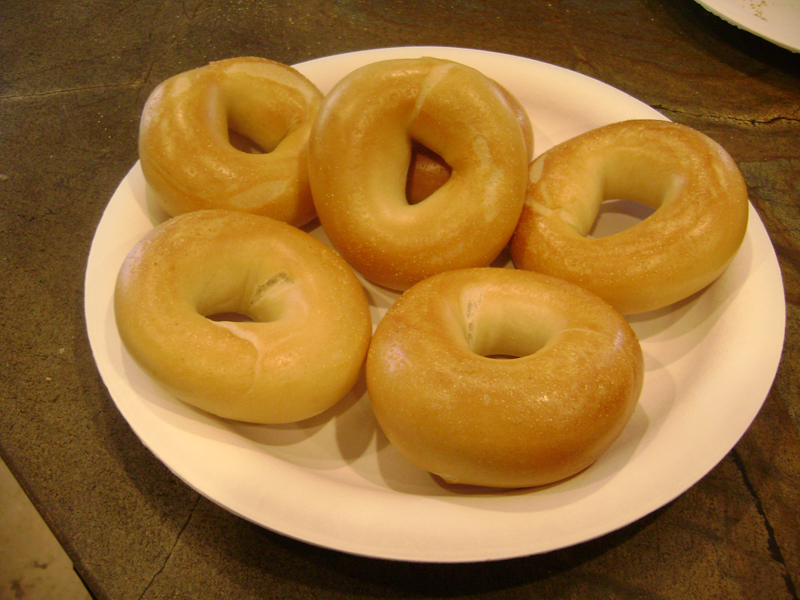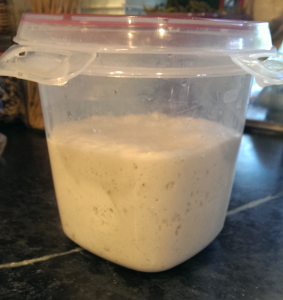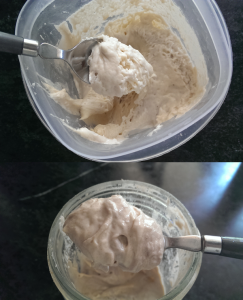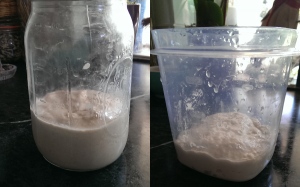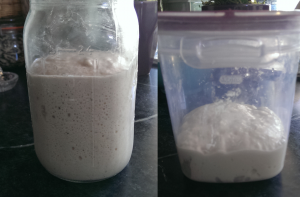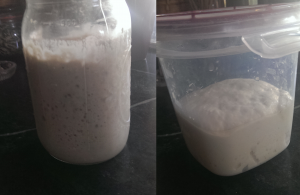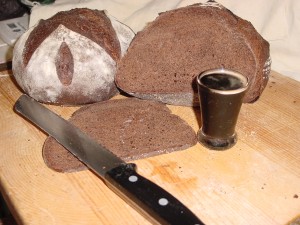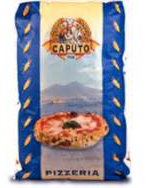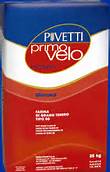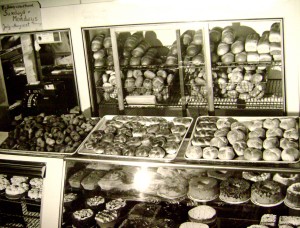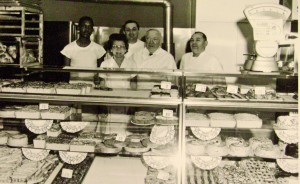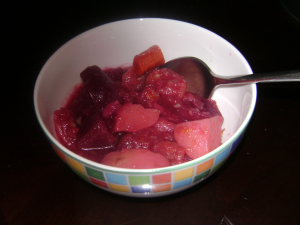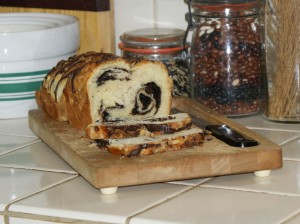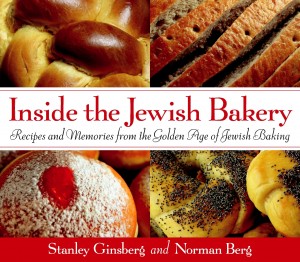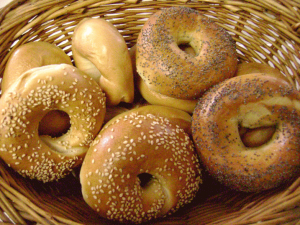 Over the past year, while I was doing personal appearances to promote my IACP award winning book, Inside the Jewish Bakery – a great read, by the way, and worth every penny – I learned that I could count on being asked two questions: “What ever happened to corn bread, aka corn rye?” and “Is it true that New York bagels are better because of the water?”
Over the past year, while I was doing personal appearances to promote my IACP award winning book, Inside the Jewish Bakery – a great read, by the way, and worth every penny – I learned that I could count on being asked two questions: “What ever happened to corn bread, aka corn rye?” and “Is it true that New York bagels are better because of the water?”
Of corn rye, more in a future post, perhaps (my list of to-do topics is growing larger). As for the water, the first time I answered it, I did so with a vehemence that surprised even me, and I can be a pretty vehement guy. But here it is, vehemence and all.
Let’s talk about water. Admittedly, there are wide swings in the taste and quality of municipal water supplies. New York City, for example, where I grew up, has water that’s sweet and drinkable right from the tap, with no off-tastes or chlorine. Nor does it scale the teakettle. Madison, Wisconsin, on the other hand, where I spent many years earning a PhD and avoiding an involuntary trip to Vietnam, had (and presumably still has), hard-as-nails water that tasted of limestone and sulfur, and which instantly coated the bottom of every pot I owned with a hard white crust. Southern California, where I live now, is somewhere in the middle: the water isn’t nearly as sweet as New York water, and the scale it deposits is negligible compared to what I contended with in the Upper Midwest.
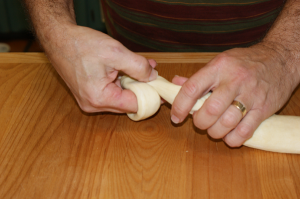 That being said – and all else equal – water, as a primary ingredient in bagels, is going to contribute to a bagel’s taste, while the mineral content may also affect the baking characteristics of the dough. On the other hand, the question then becomes, “If all else isn’t equal, what else can contribute to the wretched quality of those Wonder Bread doughnuts that continue to besmirch the bagel’s name?”
That being said – and all else equal – water, as a primary ingredient in bagels, is going to contribute to a bagel’s taste, while the mineral content may also affect the baking characteristics of the dough. On the other hand, the question then becomes, “If all else isn’t equal, what else can contribute to the wretched quality of those Wonder Bread doughnuts that continue to besmirch the bagel’s name?”
In a word (actually three) lots of things. So let’s start by deconstructing the New York water bagel. At its core, the traditional bagel recipe consists of five ingredients: high-gluten flour (100%), water (50%), salt (2%), malt (2%) and yeast (0.5% for fresh, half that for dry). Mix it up, let the dough sit for 20-30 minutes, shape the bagels and then chill them for at least 12 hours. When you’re ready to bake, boil them in water, plus a tablespoon or so of malt, right out of the fridge, and bake them at 460°F (238°C) for about 15 minutes, flipping them after 3 minutes if you’re into that sort of thing.
Those are the basics and those were the bagels I and others of a certain vintage grew up with and remember so fondly.
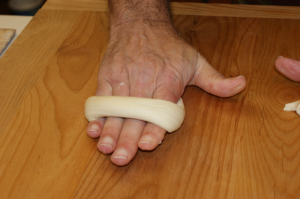 The compromises started when Daniel Thompson began marketing his father, Meyer’s, bagel-forming machine (first customer: Murray Lender), which, like the steam drill and John Henry, put the hand-rollers of New York’s Local 338 out of business. But to make the machine work properly, the water had to be increased from around 50% to more like 65%, so that the dense crumb became softer and more bread-like. Then, of course, the softer, stickier dough began to gum things up, so the steam drill guys added oil, which softened the crumb even further. So now, what once was a bagel now was becoming more like circular white bread. But the machines made mass production not only possible, but financially desirable. Enter the corporations.
The compromises started when Daniel Thompson began marketing his father, Meyer’s, bagel-forming machine (first customer: Murray Lender), which, like the steam drill and John Henry, put the hand-rollers of New York’s Local 338 out of business. But to make the machine work properly, the water had to be increased from around 50% to more like 65%, so that the dense crumb became softer and more bread-like. Then, of course, the softer, stickier dough began to gum things up, so the steam drill guys added oil, which softened the crumb even further. So now, what once was a bagel now was becoming more like circular white bread. But the machines made mass production not only possible, but financially desirable. Enter the corporations.
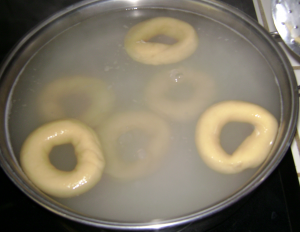 At that point, of course, the finance guys took over. Chilling takes time and costs money, in the form of energy and cooling equipment. Why not just add dough conditioners to speed gluten formation and some sugar (another crumb-softener) to give the yeast an added kick? And what about boiling, which gelatinizes the bagel’s surface starch and forms that shiny skin? Well, let’s bake them in steam-injected ovens, said the bean-counters. That way, we can save even more on the labor and equipment needed to dump the bagels into giant vats of malt-water, scoop them out, and rearrange them on boards or pans or whatever. Flipping? Nah, those schmucks out there won’t know the difference, but our shareholders will love us for cutting costs (at the price of quality, but when did that ever matter?) and giving profits a nice bump.
At that point, of course, the finance guys took over. Chilling takes time and costs money, in the form of energy and cooling equipment. Why not just add dough conditioners to speed gluten formation and some sugar (another crumb-softener) to give the yeast an added kick? And what about boiling, which gelatinizes the bagel’s surface starch and forms that shiny skin? Well, let’s bake them in steam-injected ovens, said the bean-counters. That way, we can save even more on the labor and equipment needed to dump the bagels into giant vats of malt-water, scoop them out, and rearrange them on boards or pans or whatever. Flipping? Nah, those schmucks out there won’t know the difference, but our shareholders will love us for cutting costs (at the price of quality, but when did that ever matter?) and giving profits a nice bump.
Which brings me back to the idea of “all else equal,” because in the bagel world, all else is not equal. Dunkin’ Donuts, the world’s largest bagel manufacturer, Einstein Bros./Noah’s, Bruegger, and all those Korean-owned mom-and-pop bagelries have gone over to the dark side, substituting size for quality and factory flavors like strawberry, cinnamon, blueberry and jalapeño for time, labor, and the natural action of enzymes on complex carbs.
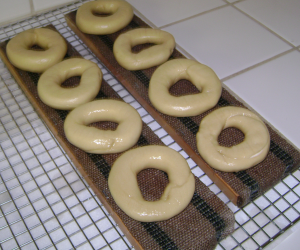 When I make bagels, I do it the same way the Local 338 guys did, hand-rolling, chilling, boiling and flipping on burlap-covered cedar boards. Even with that so-so Southern California water, I’ll put my bagels up against anyone’s, anywhere in the world. And I guarantee you, I’ll prevail 99.999% of the time – that 0.001% being when I go up against a properly made bagel using New York water.
When I make bagels, I do it the same way the Local 338 guys did, hand-rolling, chilling, boiling and flipping on burlap-covered cedar boards. Even with that so-so Southern California water, I’ll put my bagels up against anyone’s, anywhere in the world. And I guarantee you, I’ll prevail 99.999% of the time – that 0.001% being when I go up against a properly made bagel using New York water.
So does the water make a difference? Of course — if you’re eating one of those 0.001% New York bagels and one of mine. But most of the time, it’s just an excuse for incompetence.

